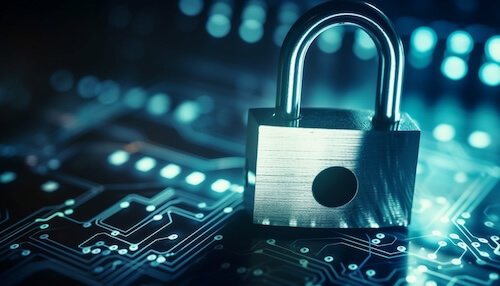Boosting Data Privacy and Security in Information Governance
Discover how data privacy and security in information governance can shield your business from breaches, ensure compliance, and protect customer...
-3.png?width=250&height=33&name=Untitled%20design%20(18)-3.png)
Understanding information security governance roles and responsibilities is a critical step in safeguarding your ...
Understanding information security governance roles and responsibilities is a critical step in safeguarding your business from cyber threats.
It is no longer an option to overlook the roles and responsibilities of information security governance; they are essential in this digital age.
The stakes are high. Data breaches can damage reputations, erode customer trust, and result in hefty financial losses.
Yet many businesses struggle to fully grasp their information security governance roles and responsibilities. Practical information governance is essential in businesses like yours, so let's read on!

In an era where digital threats are increasingly prevalent, the significance of information security governance cannot be overstated. Protecting a company's reputation and nurturing customer trust hinges on effective strategies for safeguarding data.
This highlights that strategic discussions around information security strategy aren't optional - they're necessary. Key stakeholders such as senior executives and board members play pivotal roles in these conversations - their decisions determine which risks should be accepted or mitigated.
No system is completely immune from breaches. Acceptance of this fact forms part of a proactive approach towards managing potential incidents while maintaining consumer confidence.
Business leaders have to delve into technical aspects too, learning the language of information security governance and contributing meaningfully towards establishing proper budgets for it. Their involvement ensures all employees understand their responsibilities regarding data protection.
The effectiveness of information security governance is heavily influenced by key stakeholders. These include senior executives such as CEOs, CFOs, general counsels, and heads of compliance who play pivotal roles despite their limited knowledge about specific security details.
To establish a proper information security budget and contribute effectively to discussions on information security strategy, these individuals need to engage with specialists in this field and become familiar with its unique language.
In shaping an organization's approach towards maintaining robust information security policies, executive team members are instrumental. Their understanding can help align company objectives with risk tolerance levels while promoting efficient processes across different departments.
This engagement improves communication among various stakeholders within the organization. It also eliminates redundant efforts which often arise from a lack of coordinated action or shared vision regarding potential threats facing today's digital world.
A significant part of managing both internal and external attacks falls under executive board members purview. They oversee how well organizations manage data assets - a task that helps prevent privacy violations providing greater confidence for customers and partners alike.
In essence, when boards understand their role better in upholding effective corporate governance practices, they facilitate intellectual property protection against potential risks associated with operating in our increasingly interconnected global economy.
In the dynamic landscape of today's digital world, crafting a robust information security governance framework is non-negotiable. The significance lies in aligning your business and technology strategies with this framework while maintaining regulatory compliance.
An efficient governance structure does more than just safeguard data; it allows for strategic alignment between company objectives and risk tolerance levels. This ensures that resources are effectively channeled towards mitigating risks that could significantly disrupt operations or tarnish reputation.
In the digital world, security threats are a constant concern. Businesses must ensure their information-related policies permeate every aspect of operations to fend off both internal and external attacks.
An essential tool in this process is the NIST Cybersecurity Framework. Developed by experts at the National Institute of Standards and Technology, it offers guidelines that help businesses weave cybersecurity measures seamlessly into business processes.
This framework lays out five core functions:
These steps guide you from understanding your digital environment (Identify), through implementing safeguards to protect assets (Protect), all the way up until ensuring systems can recover after an incident (Recover).
To learn more about how these steps create a comprehensive approach towards embedding security within your organization's fabric, visit NIST's official page on its cybersecurity framework here.
Following such frameworks allows organizations to be proactive rather than reactive when dealing with potential security threats. It fosters continuous improvement as new risks emerge or existing ones evolve.
These benefits make integrating information-security related policies critical for any forward-thinking enterprise today.
In the realm of information security governance, addressing and managing security breaches is a critical aspect. The process involves identifying incidents, containing them promptly, eradicating threats, and recovering systems swiftly and effectively learning from these occurrences.

A robust monitoring system plays an instrumental role in detecting unusual activity or unauthorized access attempts within your network. This initial identification step can significantly impact how well you manage the incident moving forward.
Upon detection of a breach, immediate action for containment becomes paramount to prevent further damage. Measures may include disconnecting affected systems or blocking malicious IP addresses linked with external attacks on data assets.
Eradicating threats means eliminating their root cause - this could involve deleting malware-infected files or patching exploited vulnerabilities. Following eradication comes recovery where services are restored using secure backups when necessary. In such scenarios, senior executives play pivotal roles by ensuring that business processes return to normal as quickly as possible.
The final but equally crucial part is learning from past incidents. A thorough post-breach analysis helps businesses identify areas requiring improvement so they can implement changes accordingly.
This collective body comprises senior executives from various departments and holds significant responsibility for monitoring implementation effectiveness and making time-bound adjustments.

This team's primary role revolves around ensuring that all aspects related to your company's information security strategy are effectively implemented. They keep an eye on key metrics to measure how well different components perform against set objectives.
Besides, they also act as a communication hub about potential threats or breaches within the organization. Their swift action in disseminating vital data across the business can mitigate risks significantly when required.
Picking members who will serve on your governance committee requires careful thought process. You need individuals with both a comprehensive understanding of your business processes and specific knowledge relating to their department's interaction with data assets. Learn more about selecting suitable candidates here.
To maintain effective oversight, it's crucial that regular meetings take place where updates regarding progress towards goals can be shared. These sessions provide opportunities to agree upon any changes needed, keeping strategies aligned with evolving threats and regulatory requirements. More guidance on maintaining effective oversight can be found here.
Many organizations will have key people like the CEO, CFO, head of legal counsel and others involved in information security governance. While the company's board play pivotal roles in information security governance, large organizations like yours are likely to have additional roles:

Often this person has overall responsibility for the security of an organization's information systems. This includes developing and implementing security policies and procedures, managing security staff, understanding network activity and preparing for potential threats, overseeing incident response and disaster recovery planning, and coordinating the response and recovery efforts when a data or security breach occurs. Proper information security budget is also argued for, and hopefully obtained, by the CISO.
This person is usually a level down from the CISO and maybe tasked more with the implementation and maintenance of the high level policies defined, and approved, by the CISO.
ISAs are responsible for ensuring that an organization's information assets are protected from unauthorized access, use, disclosure, disruption, modification, or destruction. They play a critical role in information security governance by helping to ensure that the organization has the right security controls in place to protect its information assets.
This person, or team of people will be responsible for setting up the defenses to protect the data and information for the company. They'll also be key in responding to threats and help train employees.
A Data Owner is the person in charge of taking care of important information, kind of like a guardian for data. Their role is to make sure that the data is kept safe, used correctly, and only accessed by the right people. They decide who can use the data, who can't, and they also make rules to keep the data secure from any potential harm
There are many benefits for large organizations when the key roles and responsibilities are well understood. These include:
Information security leaders find that information security policies are more readily implemented in an effective way across the whole organization. This, of course, leads to much improved data security when compared with ad-hoc approaches or where employees simply do not understand who has which roles and responsibilities within the company.
By having known, clear roles and responsibilities, potential issues are identified much sooner thereby leading to reduced risk of any security incident. Business functions can more quickly get back up and running following any kind of issue.
For large organizations compliance with regulations is critical. Business functions across the entire company much be aware of this fact, and by having clear roles and responsibilities teams can more quickly alert appropriate people of potential problems.
Information security governance engaging properly in appropriate aspects of business processes coupled with the knowledge around roles and responsibilities helps with business continuity. In the event of issues key personnel are already in place with the knowledge, skills and support of the executive team. Information related to events can also be cycled back through the different roles and responsibilities in order to provide even better support in the future.
In this blog we have covered information security governance roles and responsibilities.
The stakes are high with potential damage to reputations, loss of customer trust, and significant financial losses from data breaches. Key stakeholders like the CEO, CFO, general counsel, head of compliance, and board members play crucial roles in this process. Their engagement shapes the organization's approach to information security.
We've covered many other roles which large organizations like yours need to ensure good information governance policies and practices.
An effective governance framework aligns business strategy with technology while ensuring regulatory compliance. It provides numerous benefits, including improved trust with customers and protection against potential reputational damage.
Security needs to be integrated into all aspects of operations - from employee training programs to procurement procedures. This ensures comprehensive protection against both internal and external threats.
No system is foolproof though; some breaches may still occur despite best efforts. Therefore, having a plan for managing these incidents is critical, which includes steps like identifying, containing, eradicating, recovering from, and learning from these incidents.
Discover how data privacy and security in information governance can shield your business from breaches, ensure compliance, and protect customer...
Unravel the roles of information governance vs records management in business, their influence on data security, and how to balance both.
Explore Information Governance Best Practices for remote work. Learn to manage data, ensure compliance, and enhance business operations.